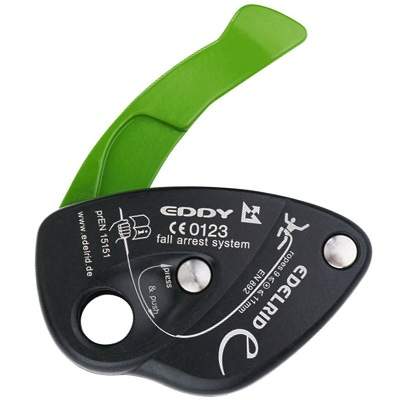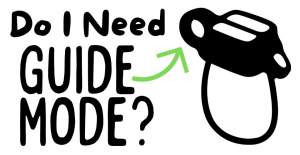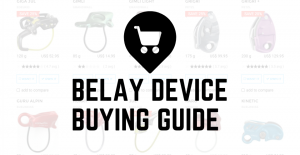How to use Eddy, inspection, lifespan and storage with instructional pictures.
Eddy
Description
Since its introduction in 2005, the Eddy has established a reputation as a safe and easy to use semiautomatic belay device predominantly for sport and indoor climbing. The Eddy is simple and safe, easy to thread, with the rope logically following the rope flow. A controlled descent with an emergency brake system eliminates the "panic pull“ syndrome which can lead to serious accidents. The Eddy provides maximum safety whether top roping or lead climbing with easy paying out of rope to the leader. Must be used with both hands. For use with single ropes from 9 to 11mm diameters.
Retail price
This Product is Hard to Find.
We don’t know where you can buy this item online in the US. We’ll continue to check all the major retailers and will update this page as soon as we find one.
If you know where to find this online in the US, let us know, and we’ll add the link.
Device Type  Device TypeTubeThe most commonly used belay type also called an “ATC” or “tuber.” Other than a distinction between other belay device types, “Tube” is a rarely used term, most climbers just assume you're talking about this style when they refer to your "belay device." 
Figure 8Mostly used in rescue, canyoneering, tactical, work safety, or by old school climbers and rappellers. One reason they went out of popularity with recreational climbers is because they tend to create twists in the rope. 
Brake AssistThese devices assist in stopping the rope when a climber falls or hangs on the rope. 
Often referred to as “auto-blocking” but that’s not the official terminology because no belay device should be assumed to work automatically by itself, even if it feels like it does (or does most the time). PlateWhen simplicity is a must, or you started climbing before Tubers were the norm. Bonus: They tend to be very light weight. 
DescenderFor rappelling, not for belaying a lead climber or top-roping. 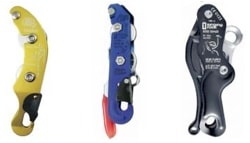 |
Brake Assist - Mechanical |
Weight (g)  Weight (g)In grams, the weight, as stated by the manufacturer/brand. |
360 g |
Belay Brake Assist  Belay Brake AssistThis is when the belay device significantly reduces the amount of holding power the belayer must exert to stop a fall and hold a climber. This is also called "assisted-braking" as the device must hold a significant amount of the climber’s weight; this term does not include friction-adding "teeth" found on some tube style belay devices. Confusingly referred to as “auto-blocking” or “auto-locking” these terms wrongly imply the device will always, automatically, stop a fall or hold a climber even if the belayer/rappeller is hands-free. These devices are not meant to be used without a hand on the braking side of the rope; the belayers/rapppeller brake hand should always be on the brake rope. Worth ConsideringMost of the mechanical brake assist devices only hold a single strand of rope and are not capable of double-strand rappelling (the most common method of rappel). |
Yes |
| Rope Options | 1 rope only |
Guide Mode  Guide ModeThis is when you belay directly off the anchor instead of your harness. Guide mode is helpful if you climb outdoors a lot because it reduces the holding power required from the belayer. When your partner falls or rests, the weight of the climber is held mostly by the anchor and the belay device. Tubers and PlatesWhen belaying in "guide mode," the tubers and plates turn auto-blocking. During a fall, the climbing rope pinches the slack rope, completely stopping the movement of either rope. A common guide mode setup shown below. 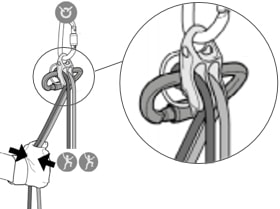
Mechanical Brake Assist DevicesThere is no difference in the functionality of the device. A brake-hand should always be on the rope to ensure the climber is caught in the case of a fall. A common guide mode setup shown below. 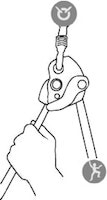
Where guide mode is used
Learn Morehttp://www.climbing.com/skill/essential-skills-auto-blocking-belay-devices/ |
1 follower only |
Teeth  TeethTeeth are only seen on tube devices. They add friction that helps grip the rope for more belaying control. This is helpful for belaying heavier climbers. Teeth are becoming standard on new tube devices. 
Worth ConsideringTeeth do wear out. You can limit wear by rappelling on the side without teeth (if you don’t need the extra friction). Once they’re worn, you’ll still have a usable belay device, just less friction. |
No |
Rope Range (mm)  Rope Range (mm)The range of rope diameters, in millimeters, that the manufacturer/brand specifies can safely be used. This is the best case scenario and does not necessarily take into consideration that certified ropes have a tolerance of +/- .3 mm. Recently, manufacturers have started to add an "optimized" rope range -- this is the range that will result in the nicest handling of the belay device. | 9.0 mm - 11.0 mm |
Certification  CertificationsThe main climbing gear certifications are CE and UIAA--and normally the UIAA creates the rules that the CE body also supports. When possible, we try to list all the certifications the product carries. To sell a climbing product in Europe, the device must be CE certified. There are no official requirements to sell climbing gear in the US. The UIAA certification is a voluntary process. Learn MoreRock and Ice Certifications Guide |
CE |
No reviews yet.
The big advantage of the Eddy is revealed when you start to use it. Somehow, the device seems to recognise the difference between a fall and an energetic payout of rope - it locks cleanly during the former whilst allowing the rope to pull through unhindered for the latter. The device locks when you apply force through the brake-hand on the dead end, when you are feeding rope through, the lack of braking force allows the device to remain open. A proper sharp tug will lock the device even if you're not gripping the dead rope, but you can unlock it, simply pulling at the dead-end will unlock the device and you can carry on - alternatively, you can manually unlock the cam with your thumb - as for a Grigri - but the design makes it impossible to hold the cam open in this way - it's simply not big enough to hold.
There was a time when the Edelrid Eddy created real competition with the original Petzl GriGri. However, with the introduction of the GriGri 2 and as rope diameters have steadily decreased, that is no longer true. Today, the Eddy feels overpriced, overweight, and outmatched in a field of belay devices that has grown lighter and smoother each passing year. Furthermore, shoppers who once looked to the Eddy for maximum safety can now consider the Camp Matik as well.
The Eddy, a rather heavy bugger at 12.4 ounces (Grigri 2 is 5.9 ounces), will also lock if the user pulls the lever all the way back. This eliminates the risk of the belayer dropping you because he freaked and yarded on the lever. I found this feature especially annoying, and even superfluous to safety. It makes the lever's range of arc that unlocks the cam extremely small -- you have to pull it back just right in order to lower your partner.
To sum up, the Eddy is okay. It will catch and lower any climber—even on, thank god, ropes down to 9 millimeters! However, compared to the no nonsense Grigri 2, I found the Eddy difficult to use.
The Edelrid Eddy is the heaviest, priciest device in this review. But where it misses in these categories, it’s a hit with durability, simplicity, and suitability for less experienced climbers. The gym is the Eddy’s native habitat. Belaying with the Eddy uses a natural-feeling hand position, very similar to using a tube-style device, and it feeds and takes in rope easily for toproping and
leading, even with crusty gym ropes. For lowering, the Eddy uses a lever much like the Grigri, but includes a built-in “panic brake” that engages the braking mechanism if a belayer tries to lower too quickly; the belayer must return the lowering lever to the braking position to “reload” the device before he or she continues lowering. This feature and the somewhat fi nicky push-button opening for loading the rope into the Eddy might annoy a climber familiar with other devices. But the panic brake could be a comfort for anyone climbing with a beginning belayer. Most of the device is constructed of steel (except the aluminum brake lever), which accounts for the Eddy’s heft, but also makes it likely to last much longer under heavy use than other devices.

